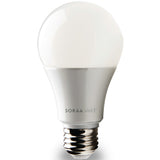Eulogy for the CFL Bulb - Why It Never Caught on With Consumers
Posted by Dave on for ProLampSales
Legislation banning common incandescent bulbs has not been well received by most consumers. CFL and LED bulbs, often mentioned as the new go-to lighting option for homes, have caused an uproar. Consumers complain that the government is making them choose between one bulb that is "cheap and doesn't work" (CFL) and another bulb that is "too expensive and doesn't work" (LED).
At the peak of these complaints, LED bulbs had cost around $35 each for a 60 watt equivalent. CFLs were far less expensive - almost as cheap as incandescent in some stores - but there had been a very rocky history with consumers and many have dug in against them. Even politicians, sensing a way to please constituents, bad-mouth the CFL.
What happened with compact fluorescent technology to create such bad feelings from consumers? CFLs, introduced commercially by Philips and Sylvania in the mid 1980s, were projected to be an energy efficient "transitional" technology between less efficient incandescent bulbs and LED technology on the horizon that was still very expensive.
The plan worked with businesses and institutions. They generally embraced CFLs, because they cut bottom line energy costs and worked well enough for their lighting applications. Even now, pin-based CFLs are ubiqitous in commercial buildings, although some are upgrading to LED CFL replacements.
From the beginning, consumers found much to complain about:
"NO INSTANT START"
Flip the switch of a table lamp - get instant light. Screw in a CFL manufactured in the 1980s and 1990s - get a faint glow for what seemed like forever until it warmed up to full light. It got worse. Screw in a CFL to an outdoor porch light. Winter arrives. Flip the switch. No light at all. Most CFLs would not come on if the temperature was below freezing.
Today, the vast majority of CFLs start instantly and have low start temperatures, although some cheaper versions can still struggle in winter.
"LIGHT DOESN'T LOOK LIKE INCANDESCENT"
The warm soft white light of incandescent bulbs was not easy to match for compact fluorescent. The color temperature of early CFLs always seemed a little weird. For the CFLs that were marketed as 2700K, warm white, they had a greenish-yellow cast that didn't work for consumers. The compact fluorescent sweet spot has always been cool white, which is why the business and institutional sector in particular embraced them. But cool white is not what most consumers want in their living room.
Again, most of this is ancient history. Today, 2700K CFLs are a much closer match to incandescent warm light due to advances in phosphors and lighting technology in general.
"WHY CAN'T I DIM IT"
Another fatal flaw that in many ways continues to haunt CFLs is that they are not all dimmable. They can dim, but you can't just grab any CFL off the shelf like you can with incandescent or halogen.
The dimming CFLs are marked as such and are usually considerably more expensive. Homeowners don't want to read tiny labels on boxes of light bulbs to determine if they are getting the right product.
"THEY'RE TOXIC, THEY CONTAIN MERCURY"
Fluorescent technology uses mercury vapor, a key component in how it produces light. This is true of all fluorescent lamps, including linear tubes. The technology has improved to the point that the mercury levels are lower, but nevertheless, CFLs are still considered toxic enough that some states have regulations about disposal of burned out or broken bulbs.
For the most part, CFLs are RoHS compliant, meaning they can simply be tossed in a trashcan, but homeowners have never been comfortable having light bulbs with mercury in their homes. Accidents can happen at any time, and manufacturers still recommend airing out a room if a fluorescent bulb is shattered.
"THEY'RE HUGE LIGHT BULBS"
CFL bulbs were often larger than equivalent incandescent or halogens, especially in A-shape bulbs At higher lumen outputs, the CFLs had to utilize larger or longer tubes, and those spirals had to go somewhere. In addition, CFL bulbs have an integrated electrical ballast, taking up even more space.
THE BAD START, LEFT A BAD TASTE
Even though the CFL today is a mature, very affordable technology without most of the problems of the past, many consumers will not give them a second look and have moved on to LED. Today, they are used as the target for people irate about the most recent incandescent or halogen ban. That said, many consumers have found a place for CFLs in their homes. They use them in closets, pantries, basements, garages and as outdoor lights. All excellent opportunities to play to the strengths of CFLs - long life and energy efficiency.
However, with a rapid decline in the prices of LEDs, CFLs will probably always play a bit role for consumers. Walk into a home improvement store today and you'll find mostly LED bulbs front and center. CFLs may not even be there at all, or are pushed to the bottom shelf for some specialty applications.
The dream of a "transitional" CFL technology never caught on with consumers. For most, it has been a move directly from incandescent to LED, a technology that seems to do everything incandescent can do and more. The only drawback has always been up front cost. Now that barrier has almost disappeared. In a few years, most consumers will likely have replaced all of their old and burned-out CFL bulbs with LEDs.
- Posted in Fluorescent
Featured Products (View All)
0 Comments




